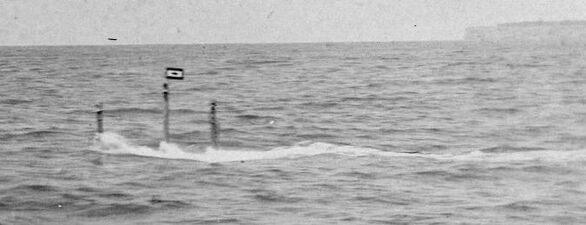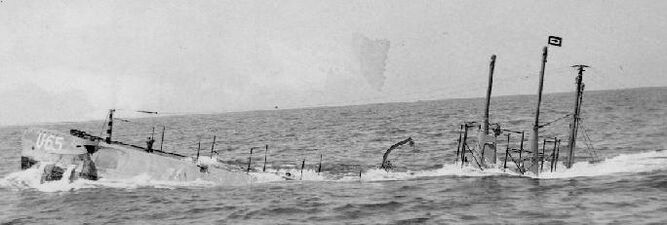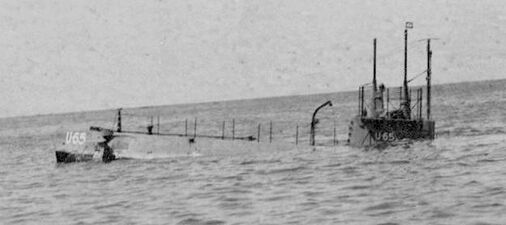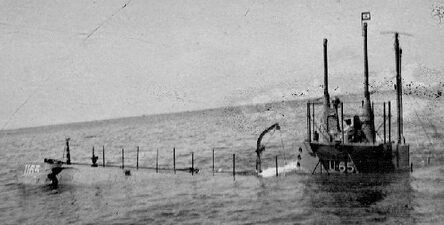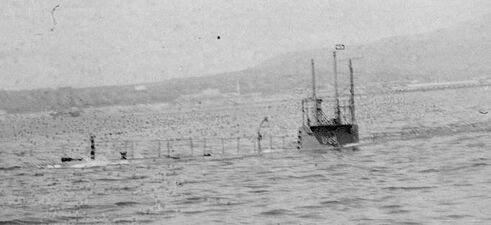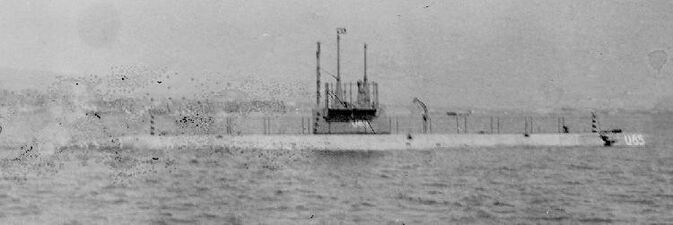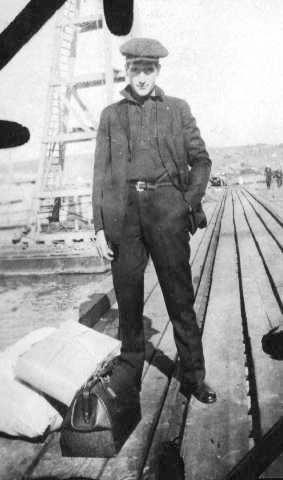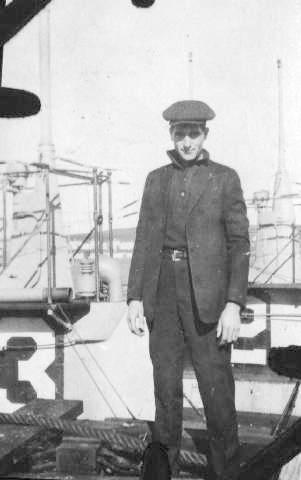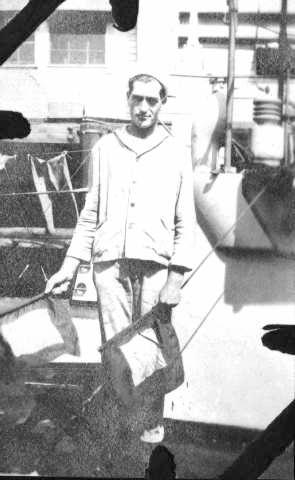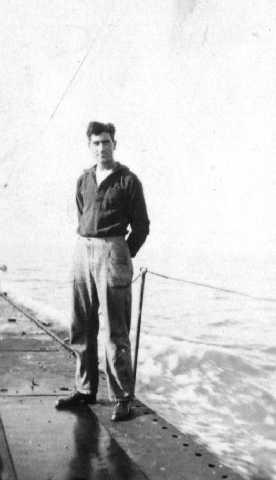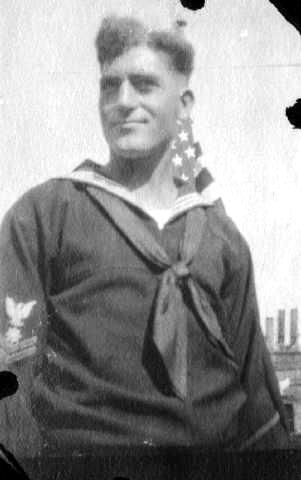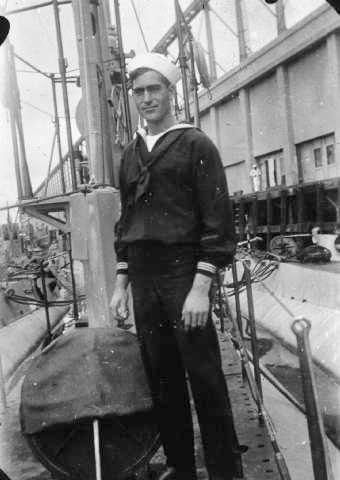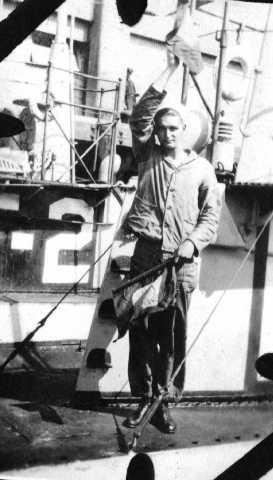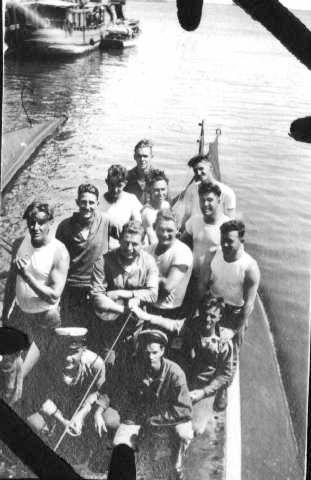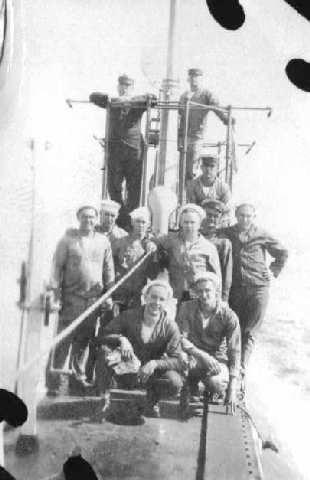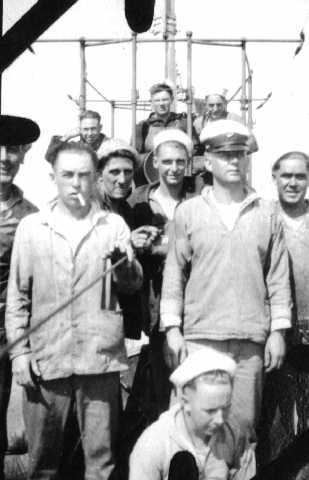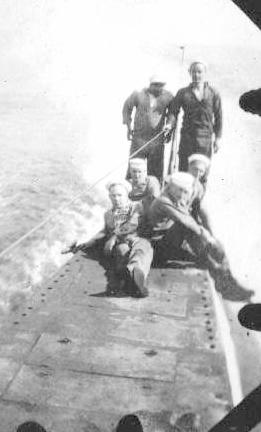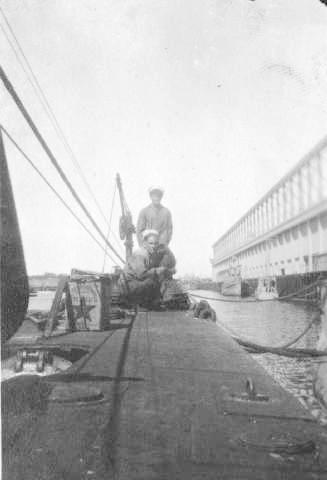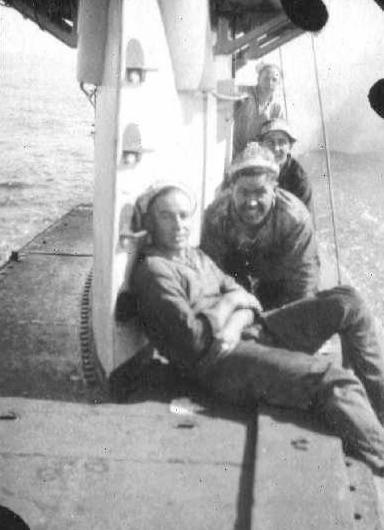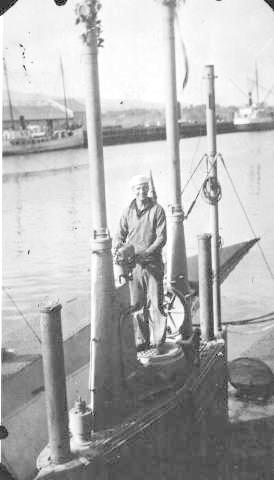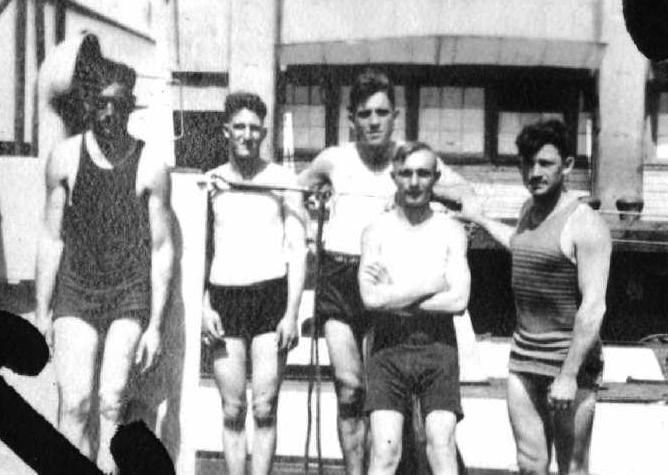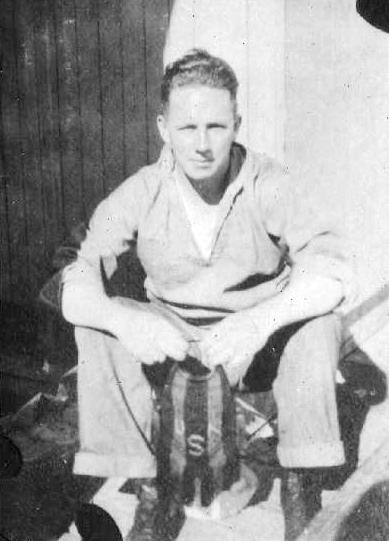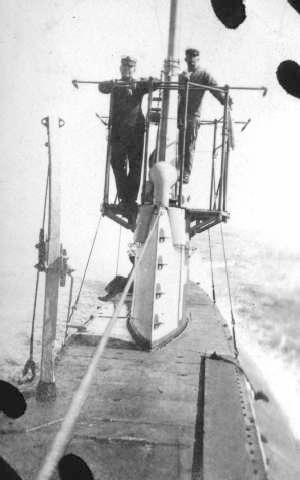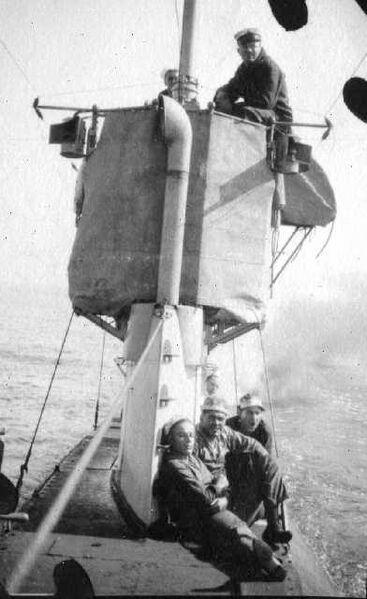Glover F-3 photos: Difference between revisions
No edit summary |
No edit summary |
||
| Line 102: | Line 102: | ||
Anytime a tube was flooded and not fired the torpedo was pulled from the tube and given maintenance. Having a rotating bow cap with two openings anytime the cap was rotated at least two tubes would flood. The Gunner's Mates (Torpedomen) were a busy bunch. | Anytime a tube was flooded and not fired the torpedo was pulled from the tube and given maintenance. Having a rotating bow cap with two openings anytime the cap was rotated at least two tubes would flood. The Gunner's Mates (Torpedomen) were a busy bunch. | ||
The torpedo is most likely a Bliss-Leavitt Mark 7 torpedo. These were put into use by the Navy in 1912 and were in use by submarines that fired the 18 inch torpedo through 1945. In actuality the dimensions were 17.7 inches (17 and 11/16 inches) in diameter and 17 feet long. The torpedo tube itself was 18 inches in diameter and 17 feet 4 inches long. The warhead could carry 326 pounds of TNT or TPX (Torpex) Torpex is 50% more powerful than TNT by mass and | The torpedo is most likely a Bliss-Leavitt Mark 7 torpedo. These were put into use by the Navy in 1912 and were in use by submarines that fired the 18 inch torpedo through 1945. In actuality the dimensions were 17.7 inches (17 and 11/16 inches) in diameter and 17 feet long. The torpedo tube itself was 18 inches in diameter and 17 feet 4 inches long. The warhead could carry 326 pounds of TNT or TPX (Torpex) Torpex is 50% more powerful than TNT by mass and both were detonated by a contact exploder. They had a range of around 6000 yards and were steam powered. They weighed in at 1628 pounds each. | ||
[[File:Red bar sub new.jpg]] | [[File:Red bar sub new.jpg]] | ||
Revision as of 14:42, 6 November 2023

Notes
SPECIAL NOTE. All photos on this page are the personal property of the Glover/Loushin family and MAY NOT BE USED OR REPOSTED without their specific written permission.
F-3 movie role as U-65
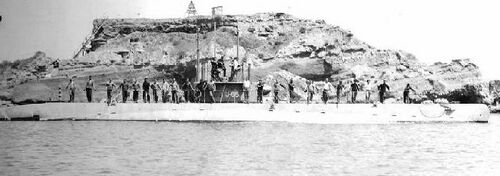
This photo shows F-3 at rest with Deadman's Island in the background. Deadman's Island and Reservation Point were dredged away in 1928 as part of a harbor development effort. The island was in the main channel of the Port of Los Angeles and was dynamited and dredged away, with the resulting rubble used to add 62 acres to the southern tip of Terminal Island.
Photo gallery of George Glover
Various Crew Photos
F-3 interior photos
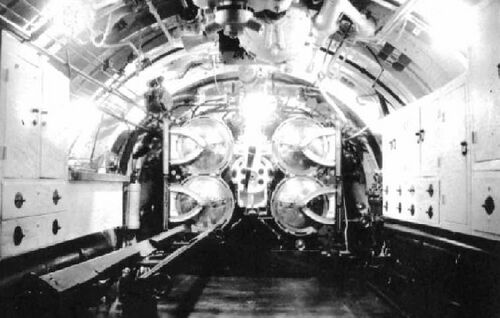
The F-class carried four torpedoes and no re-loads. As it is the total weight of the 4 torpedoes is 6512 pounds or 3.2 tons.
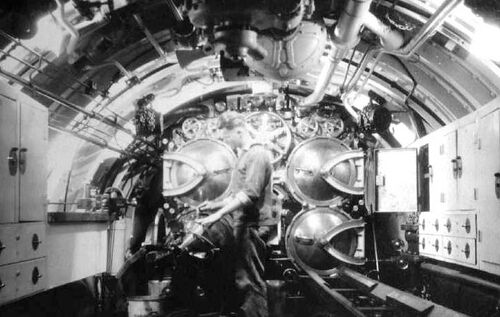
A crewmember working on a torpedo sticking out of torpedo tube number 4. Behind him can be seen a torpedo skid in front of the number 3 torpedo tube door. Chain fall hoists for torpedo handling can be seen hanging from the overhead, port and starboard above the top torpedo tube doors. Lockers held equipment for working on the torpedoes.
Anytime a tube was flooded and not fired the torpedo was pulled from the tube and given maintenance. Having a rotating bow cap with two openings anytime the cap was rotated at least two tubes would flood. The Gunner's Mates (Torpedomen) were a busy bunch.
The torpedo is most likely a Bliss-Leavitt Mark 7 torpedo. These were put into use by the Navy in 1912 and were in use by submarines that fired the 18 inch torpedo through 1945. In actuality the dimensions were 17.7 inches (17 and 11/16 inches) in diameter and 17 feet long. The torpedo tube itself was 18 inches in diameter and 17 feet 4 inches long. The warhead could carry 326 pounds of TNT or TPX (Torpex) Torpex is 50% more powerful than TNT by mass and both were detonated by a contact exploder. They had a range of around 6000 yards and were steam powered. They weighed in at 1628 pounds each.
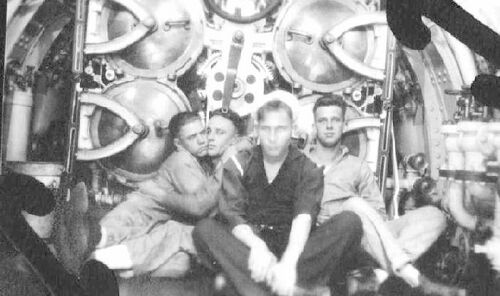
Some crew in the torpedo room goofing off for the camera. The man in the center, a Seaman 1st Class, had been identified on the photo back as a stowaway. Whether this is true or not isn't known. He may be just a visitor or had really gotten aboard and had gone to sea with them. He is wearing a set of wool undress blues (no stripes around the collar cuffs) and the rest of the men with him are in dungarees. Rarely would that uniform be worn aboard a submarine.
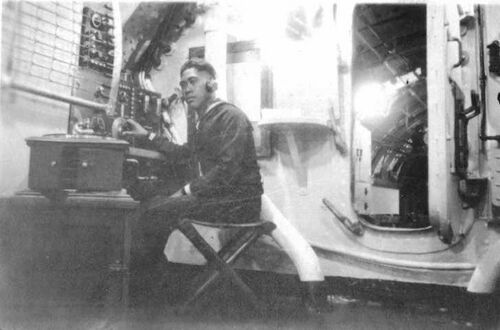
A crew man using the radio set. The man appears to be the Officers Steward or Mess Attendant. Through the door can be seen the lockers in the torpedo room. That would make the location of the radio station on the port side of the boat at the forward end of the battery space. A hand wound record player can be seen on the left side of the photo.
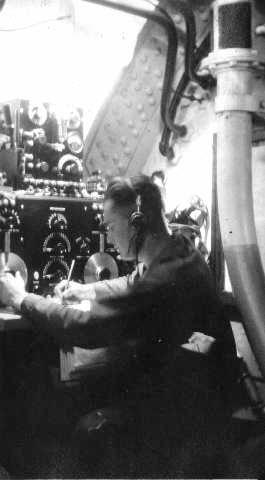
EM 2c (Radio) G. Reed working at the radio set. Working these radios required a well developed set of skills and a great set of ears. Radio technology of the day was primitive, with only Morse code and no voice capability. The sets were complex and somewhat unreliable, and were prone to short circuits and flashovers when they got damp in the dank atmosphere of the boats.
The curving pipe is one of the ventilation pipes for the Battery Well. These are usually at the forward and after ends of the battery wells and have a fan built into them to help remove dangerous gases that can build up there from accumulation. Note there is a screened top to the pipe.
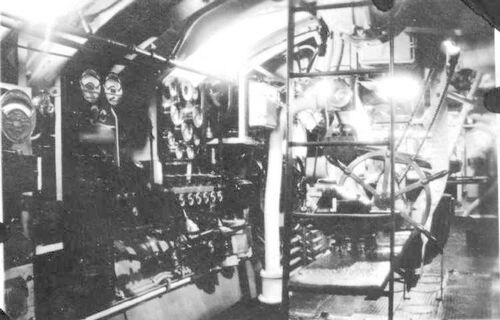
The control room of the F-3 looking forward and port. The forward and after battery compartments and the control room were all one compartment, without a bulkhead to separate them. In the foreground is the ladder leading up to the conning tower. Beyond that is the helm wheel. Electrical panels for distribution of power from the battery are on the left.

F-3 control room. The view is to starboard and forward. The large white object is electric motor for the pump station. This could be the motor that ran several pumps or just one. Most likely this is for trimming the submarine by pumping water to forward and aft trim tanks, auxiliary tanks and in and out of other ballast tanks of the submarine.
Electrical panels are seen to the right. Far left in the photo can be seen the Kingston valve operating levers at a slight angle to the right of the large white pipe. The galley is to the left of these levers. The shape of the heating oven and locker below are just seen through the rungs of the bridge access ladder.
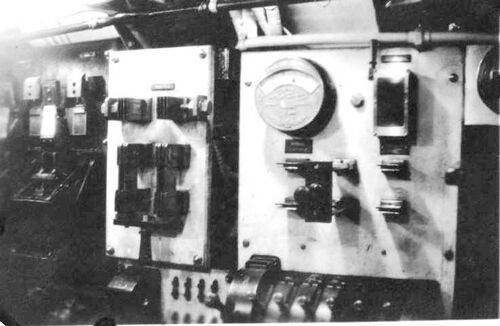
A view of the electrical panels just aft of the pump shown in the above photo.
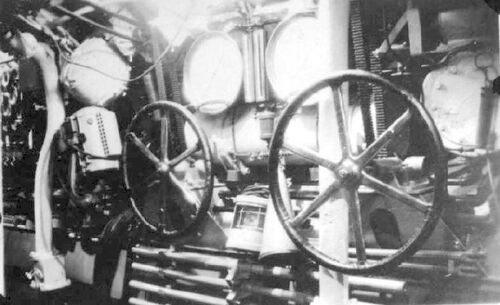
Bow and stern planes hand wheels. Bow planes to the right, stern planes to the left. This is on the port side of the control room forward of the electrical panels. Two depth gauges are seen above the wheels.
Also seen behind the wheels are chains or ribbed belts that take the movement of the wheels to gear boxes above then transfer that leverage to the control rods in the overhead to the bow and stern planes. The wheels are this large to increase the leverage to turn all that resistance. No power steering here.
Below the planes wheels, the lengths of pipe are part of the portable frame for the canvas bridge structure that had to be disassembled and taken below before diving.
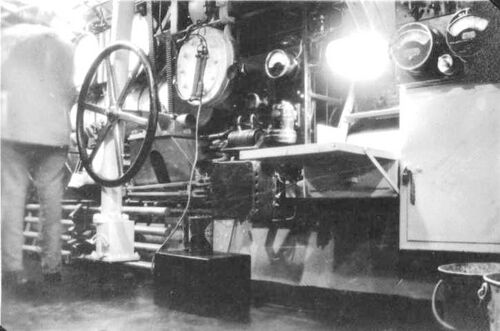
Just forward of the dive station a fold out desk can be seen. A crewman stands at the left side of the photo. On the bottom of the vertical white pipe can be seen a flapper valve indicator. These are probably for battery well ventilation. The bridge frame pipes are again seen just behind the flapper valve.
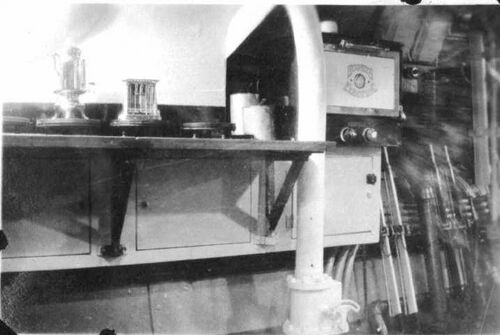
Starboard side, forward. The galley facilities aboard the F-3 are pretty basic. There appears to be several hot plates on the counter with an old-fashioned toaster and a coffee urn. To the right of the white pipe is an heating/baking oven and storage lockers below for food and pots and pan storage. At the far right are the Kingston valve operating levers.
You must remember these were Coastal Defense Submarines and not really meant to have sustained times at sea. A couple of days were what was expected of these vessels before a return to a Port or Tender vessel with full messing and berthing facilities.
Various photos

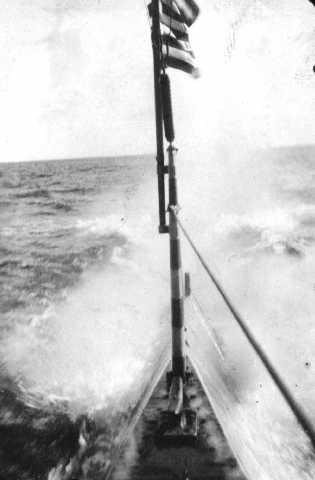
A view looking aft at sea, across the F-3 superstructure skeg that leads down to the rudder.
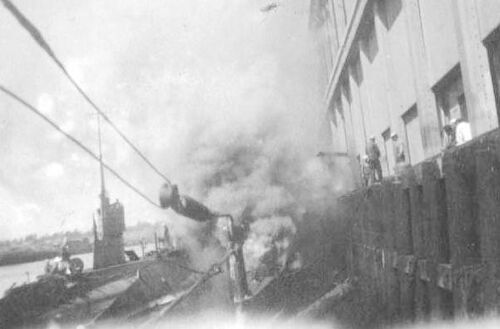
A nest of submarines tied up to the pier at San Pedro, approximately 1919-1920. Two of them are the two remaining F-class boats. This is a serious amount of smoke. It is black in color and this indicates a petroleum fueled fire. If this was smoke from starting the engines it would be white. What exactly is going on here is not known.
Page created by:
Ric Hedman & David Johnston
1999 - 2023 - PigBoats.COM©
Mountlake Terrace, WA, Norfolk, VA
webmaster at pigboats dot com




